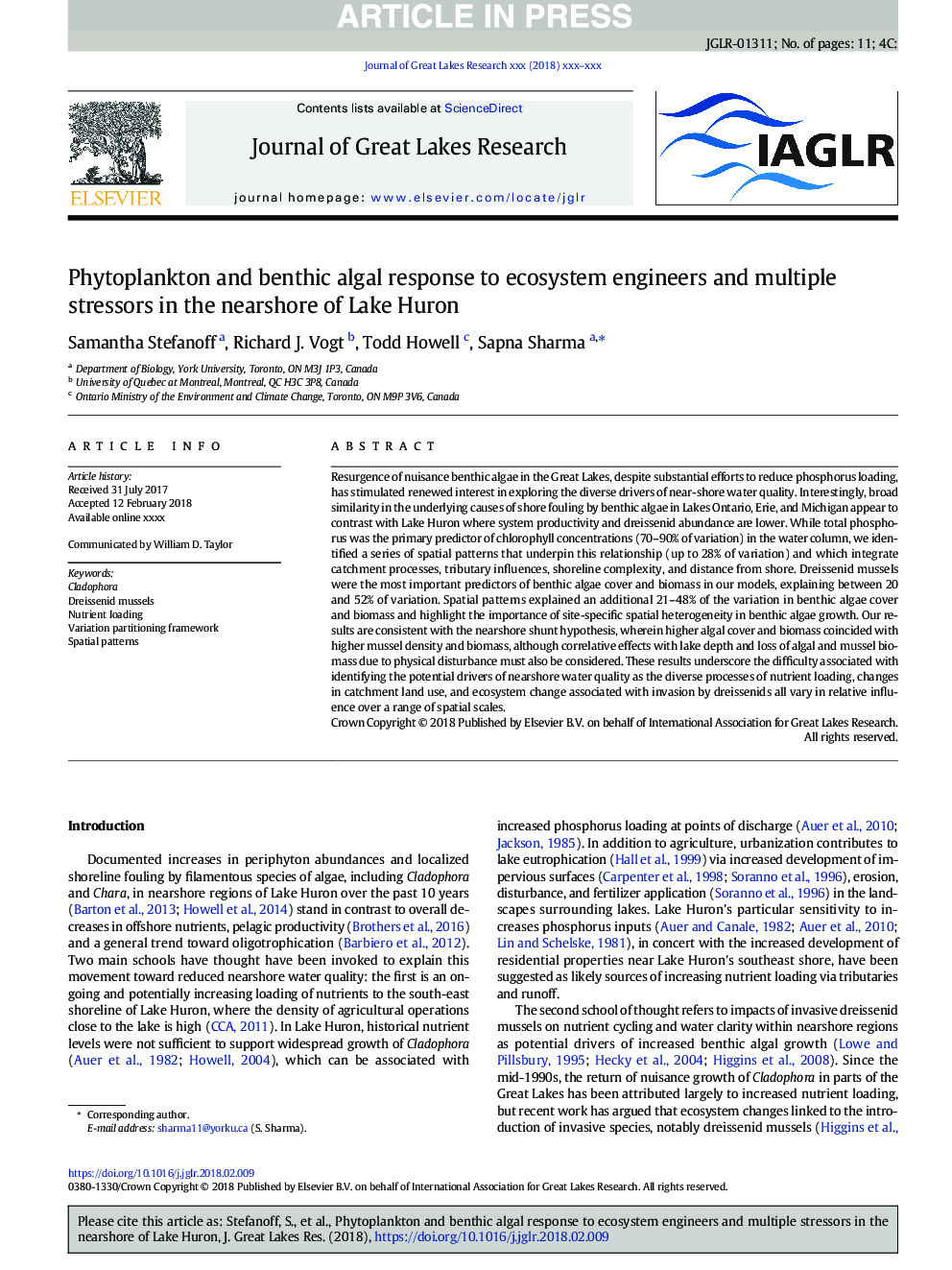| کد مقاله | کد نشریه | سال انتشار | مقاله انگلیسی | نسخه تمام متن |
|---|---|---|---|---|
| 8849109 | 1618515 | 2018 | 11 صفحه PDF | دانلود رایگان |
عنوان انگلیسی مقاله ISI
Phytoplankton and benthic algal response to ecosystem engineers and multiple stressors in the nearshore of Lake Huron
ترجمه فارسی عنوان
پاسخ فیتوپلانکتون و جلبک دریایی به مهندسین اکوسیستم و عوامل استرس زا در نزدیکی دریاچه هورون
دانلود مقاله + سفارش ترجمه
دانلود مقاله ISI انگلیسی
رایگان برای ایرانیان
کلمات کلیدی
ترجمه چکیده
احیای جلبکهای بتنی مزاحم در دریاچه های بزرگ، با وجود تلاش های قابل توجه برای کاهش بار فسفر، علاقه ای تازه به کاوش رانندگان متنوع کیفیت آب های نزدیک به دریا را به دنبال دارد. جالب توجه است، شباهت وسیع در علل اساسی جلبک های بتنی در دریاچه های انتاریو، اری و میشیگان، در مقایسه با دریاچه هورون، جایی که بهره وری سیستم و فراوانی دیرسنید پایین تر است، به نظر می رسد. در حالی که کل فسفر پیش از غلظت کلروفیل اولیه (90-70 درصد از تغییرات) در ستون آب بود، ما تعدادی از الگوهای فضایی را که این رابطه را تشکیل می دهند (تا 28 درصد از تغییرات) شناسایی کردیم و این که پروتکل های آبریز، ، پیچیدگی ساحلی، و فاصله از ساحل. موزه های دیریسنید مهمترین پیش بینی کننده های پوشش جلبک های بنتونیک و زیست توده در مدل های ما بوده اند و بین 20 تا 52 درصد تغییرات را توضیح می دهند. الگوهای فضایی توضیح می دهد که 21-48 درصد از تغییرات در پوشش جلبک های بنتسی و زیست توده را توضیح می دهند و اهمیت ناهمگنی فضایی محل را در رشد جلبک های بتیز نشان می دهد. نتایج ما مطابق با فرضیه شانۀ ناصرخسرو است، در حالی که پوشش گیاهی و زیست توده بالاتری با تراکم و مایع زیست توده بالاتر است، اگرچه اثرات همبستگی با عمق دریاچه و تلفات زیست توده جلبک و گوسفند به علت اختلال فیزیکی نیز باید مورد توجه قرار گیرد. این نتایج، مشکلات مربوط به شناسایی رانندگان بالقوه کیفیت آب دریای دریایی را به عنوان فرآیندهای مختلف بارگذاری مواد مغذی، تغییرات در استفاده از اراضی حوضه و تغییر اکوسیستم در ارتباط با تهاجم دیریسنیدها که در اثر نسبی در طیف وسیعی از مقیاسهای فضایی متفاوت است، نشان می دهد.
موضوعات مرتبط
مهندسی و علوم پایه
علوم زمین و سیارات
علوم زمین و سیاره ای (عمومی)
چکیده انگلیسی
Resurgence of nuisance benthic algae in the Great Lakes, despite substantial efforts to reduce phosphorus loading, has stimulated renewed interest in exploring the diverse drivers of near-shore water quality. Interestingly, broad similarity in the underlying causes of shore fouling by benthic algae in Lakes Ontario, Erie, and Michigan appear to contrast with Lake Huron where system productivity and dreissenid abundance are lower. While total phosphorus was the primary predictor of chlorophyll concentrations (70-90% of variation) in the water column, we identified a series of spatial patterns that underpin this relationship (up to 28% of variation) and which integrate catchment processes, tributary influences, shoreline complexity, and distance from shore. Dreissenid mussels were the most important predictors of benthic algae cover and biomass in our models, explaining between 20 and 52% of variation. Spatial patterns explained an additional 21-48% of the variation in benthic algae cover and biomass and highlight the importance of site-specific spatial heterogeneity in benthic algae growth. Our results are consistent with the nearshore shunt hypothesis, wherein higher algal cover and biomass coincided with higher mussel density and biomass, although correlative effects with lake depth and loss of algal and mussel biomass due to physical disturbance must also be considered. These results underscore the difficulty associated with identifying the potential drivers of nearshore water quality as the diverse processes of nutrient loading, changes in catchment land use, and ecosystem change associated with invasion by dreissenids all vary in relative influence over a range of spatial scales.
ناشر
Database: Elsevier - ScienceDirect (ساینس دایرکت)
Journal: Journal of Great Lakes Research - Volume 44, Issue 3, June 2018, Pages 447-457
Journal: Journal of Great Lakes Research - Volume 44, Issue 3, June 2018, Pages 447-457
نویسندگان
Samantha Stefanoff, Richard J. Vogt, Todd Howell, Sapna Sharma,
